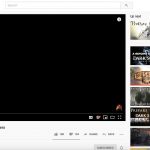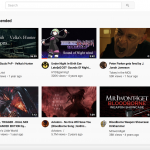YouTube is a website that many people are familiar with. It’s focused on letting anyone create and upload videos into an archival based system, in which everyday visitors of the site can search for and discover by simply utilizing the basic functions of YouTube. Over the years, it has become a popular source of revenue and many have tried to make their living off of entertaining others. From video games to recordings of legal disputes, YouTube has it all. On the surface, it may seem that the website is focused on providing consistently entertaining videos tailored to the user’s interests. Though it may have started like this, it’s consistent shift towards a business-like model has encouraged more deceptive implementations to generate more revenue.
On February 14, 2005, YouTube was founded by Chad Hurley, Steve Chen, and Jawed Karim. These three were former PayPal employees and knew each other from work. In the preview to the interview linked above, Chad Hurley and Steve Chen are asked about their thoughts on YouTube by interviewer Charlie Rose. Chen provides a short story of how the trio were at a dinner party in January 2005, where they were taking pictures and videos. They found it simple to share the photos with one another but sharing videos just wouldn’t work.
“…but when we tried to share the movies, you know we tried to email it back, but it kept getting rejected, bounced back, tried to upload it.”
Chen then mentions how there were many different systems in place in a video that could prevent people from easily sharing with one another. With the rise of cameras being able to take videos, the trio saw a unique problem on the rise that Chen explains.
“…this was going to be more of a problem for other people and we tried to make and simplify this process to make it as easy as possible to share these videos online.”
Come February, they had launched YouTube in its infant stage and officially got the site up and running around May, according to Hurley. Hurley also comments on the theme behind YouTube.
“…touching on our experience at PayPal… we saw the power of simplifying a process and giving everyone a solution. So, in that case being early employers there [at PayPal] we did that for payments, and we saw the same opportunity here in the video space.”
Hurley goes on to describe YouTube as a way for users to interact with something other than television. He even likens it to the rise of video games and other media that let consumers have a choice. He finishes this topic with a statement of how the original founders saw YouTube,
“…we see ourselves building the next generation platform to serve media worldwide.”
Hurley goes on to explain that YouTube acted as a stage for people to be seen on. Charlie Rose asks about users who make albums and music, and Hurley confirms that they have been rather successful, stating that one user in particular even got signed by a company to make their own show.
H: “…so, this is now giving people a new opportunity to be seen and that’s what we see ourselves as doing is creating a stage for everyone to participate on.”
CR: “The stage for anyone with a video camera.”
H: “Yeah, anyone.”
What Hurley says is critical in understanding the early identity of YouTube. Paired with Chen’s personable story on how the idea of YouTube was concocted in the first place, one gets a humbling image of the creators of YouTube. The problem they saw was not being able to easily share videos with people you knew, so they created a website that allowed one to do just that. As YouTube rapidly grew, they saw that they now had a business opportunity at hand. Still, from the way they talk about the website, this shows that they were primarily focused on providing a pleasant experience for the user. Whether it was giving users an avenue to consume media made by other people just like them and give them a choice in what they consumed or offer a stage for anyone with a video camera to be seen by big companies.
As such, YouTube from 2005 to 2006 was focused primarily on the user and solving a problem that many would have encountered if not for YouTube.
Google officially purchased YouTube from the founders on October 9, 2006. From here, I will be going off of information provided by Nicholas Jackson (2011), who wrote an infographic containing the history of YouTube. As views continued to climb, YouTube officially inserted their first in-video advertisements around August 2007. In 2008, companies that advertised on YouTube would pay the users directly a certain amount of money depending on how many views their videos accrued. Arieez Dutta (2019) mentions in his article covering how YouTube generates revenue that landing page advertisements, sponsored videos, and embedded advertisements are the some of the most common ways money is made on the site.
What’s interesting is that there seems to be no official interview with Google on their thoughts about YouTube and how they plan on running it. There is a general statement of what they hope to achieve with YouTube, which can be found here, but the lack of a recognizable face makes them less credible than the likes of Hurley and Chen. Though Karim was not part of the interview, he starred in the very first video on YouTube. This too does wonders for his credibility and as such makes all three of the founders more trustworthy and personable in comparison to the faceless owners from Google.
Featured below is co-founder of YouTube, Jawed Karim, starring in the first video on YouTube about being at the zoo.
A good example of Google’s influence on YouTube can be found as soon as one enters the site. For this, I will be providing my own screenshots of my YouTube homepage and providing accounts of my own experience. It’s no secret that YouTube has an algorithm bot that recommends videos based on past searches a user makes. I have noticed on several occasions that even if I just Google something, it will often appear as a recommended video sooner or later. The “purpose” of the recommended function is to seem like it is providing relevant material to the user, who may or may not find use in them, but this is far from the case. The evidence lies no further than a function often paired with the recommended feature: the autoplay function.
As you can see from a screenshot I provided, I’ve clicked on a video by VaatiVidya, a user who often analyzes the lore behind games. The autoplay function is automatically activated (even if I deactivate it, the function is automatically switched back on every time I get back on YouTube) and at the end of the video, the next one will play, even if I’m not in the tab. This may seem harmless as it simply moves me to the next video by VaatiVidya. It can be useful to automatically progress through videos, removing the need for me to manually do it. However, the problem here is that the design of such a feature is specifically meant to force users to watch more videos. It is subtle but the results speak for themselves. Users would likely forget autoplay is on when they click on a recommended video and are pushed along to the next related video. This generates a view for the next video and even better if the next video has advertisements. This in turn creates more revenue for YouTube, as they have gently forced a user to watch a video they otherwise may have never viewed.
Others have suspected and confirmed similar findings. Már Maack (2019) recently wrote an article discussing the hazards of the recommendations tab. In it, he included a quote from Guillame Chaslot, who used to work at Google on YouTube’s recommendation functionality.
“It isn’t inherently awful that YouTube uses AI to recommend video for you, because if the AI is well tuned it can help you get what you want. This would be amazing,” Chaslot told TNW. “But the problem is that the AI isn’t built to help you get what you want — it’s built to get you addicted to YouTube. Recommendations were designed to waste your time.”
Even the homepage of YouTube falls into deceptive practice. Featured below are two screenshots I took on two different days of my YouTube homepage.
As you can see, the very first thing I see on the homepage is the recommended tab. Not my subscriptions, the content creators that I specifically enjoy and wish to see more from, but recommendations. They are similar to the media I like, perhaps even enough to make me spend a few hours just clicking through videos on YouTube, but not what I originally wanted. At most, one or two subscribed channels will appear on the homepage from what I’ve seen. On the second day, I was even recommended more music than normal since I often use YouTube to play video game original soundtracks while I do homework, study, or write.
All of this is evidence that a deceptive mechanism is at play here. The original YouTube from 2005-2006 seemed to be more focused on the user. The founders – Chen, Hurley, and Karim – all wanted to provide a platform of media to give choice to the consumer, solve a problem, and give users a chance to be seen as content creators. Now, with Google in charge, YouTube has taken on more business-like practices, but still tries to mask itself with the welcoming image that the founders gave the website. They are now a business that profits off of views, but it almost seems as if wasting your time is their ultimate goal. The website is setup to make it easy to get lost in the recommended tab, which in turn generates more views on more videos and gives YouTube more money from advertisers. If YouTube started with only the subscription tab, it’s likely most users would just watch content from the people they like, then exit YouTube.
In conclusion, YouTube is a website that allows any and all to create videos, but employs deceptive, subtle tactics to keep users watching videos. The recommended tab provides videos that are mostly related to the topics the user is interested in, but tend to lead users on long watching sprees. Paired with the autoplay feature, it’s likely that YouTube is more focused on making money now rather than providing a simple, useful platform that all can use for their own benefit. This in turn is possibly caused by the change in ownership and therefore a change in vision.



